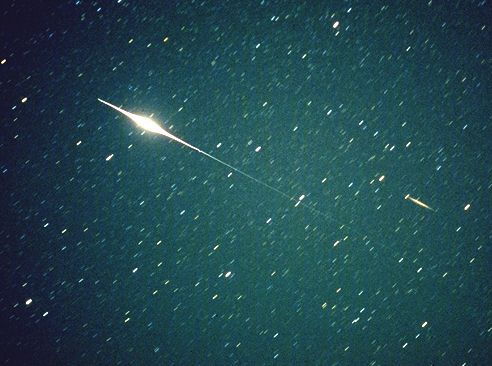Credit & Copyright: Chris Dorreman
Explanation:
Have you seen
an Iridium flare?
Satellites in
low Earth orbit
reflect sunlight and
are often visible
gliding across early evening and predawn skies.
But sun glints from
Iridium commercial digital communications satellites
are providing the most spectacular sightings.
This Iridium flare photographed on September 20, 1997 by Belgian
amateur astronomer
Chris Dorreman
reached an impressive -8 magnitude (about as bright
as the half illuminated Moon).
The one minute long exposure shows
star trails nearly perpendicular to
the bright, flaring track of the satellite
and a "ghost" image of the flare at the far right.
Iridium is the 77th element and so was a good
name for the originally intended constellation of 77 satellites.
Subsequently, plans were scaled down to 66 satellites
with about 51 now in orbit and glinting away.
Typical flares last 10 to 20 seconds.
When can you catch a flare?
The brightness, timing, and direction of a flare
depend critically on your longitude and latitude, but
satellite observers can make
accurate predictions days in advance.
1999 2000 2001 2002 2003 2004 2005 2006 2007 2008 2009 2010 2011 2012 2013 2014 2015 2016 2017 2018 2019 2020 2021 2022 2023 2024 2025 |
Январь Февраль Март Апрель Май Июнь Июль Август Сентябрь Октябрь Ноябрь Декабрь |
NASA Web Site Statements, Warnings, and Disclaimers
NASA Official: Jay Norris. Specific rights apply.
A service of: LHEA at NASA / GSFC
& Michigan Tech. U.
|
Публикации с ключевыми словами:
Iridium sattellite - Earth orbit - ИСЗ
Публикации со словами: Iridium sattellite - Earth orbit - ИСЗ | |
См. также:
Все публикации на ту же тему >> | |
